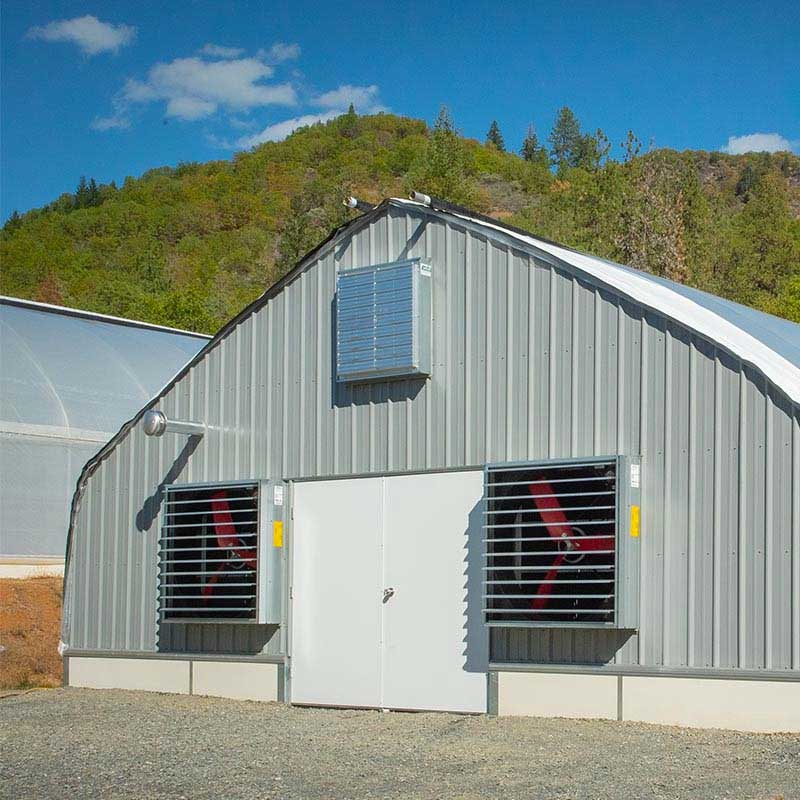Gutter Connect Greenhouses: Large-Scale Efficiency

Gutter Connect Advantages
- Optimizes space usage, allowing growers to maximize commercial capacity.
- Creates efcient climate control and irrigation systems across connected structures
- Offers more exibility for different crops, operations, and production workows.
- Scales with farmers wanting to expand greenhouse units as farms thrive.
Greenhouse Kit Comparison
Gutter connect greenhouses are highly efficient for large-scale operations, but they can require more upfront investment than smaller growers prefer. The design’s scale usually demands professional installation, unloading, and ongoing maintenance.
Gutter Connect Greenhouse Details

Recommended products

Guardian Greenhouse
Starting at: $10,273.00

Guardian Greenhouse
Starting at: $10,273.00

Guardian Greenhouse
Starting at: $10,273.00

Guardian Greenhouse
Starting at: $10,273.00
Gutter Connect Greenhouse Benefits & Use Cases
Benefits
These structures offer dependable performance through well-established design principles, avoiding unnecessary complications. The focus on reliability over novelty provides the most consistent results that experienced farmers value, supporting steady production with less labor and fewer changes to operations.
Use Cases
The united growing environment helps farmers maintain consistent commercial production, boosting output potential and reducing multi-span complexity. Farmers particularly value the streamlined workflow that connected gutter greenhouses offer. Operational simplicity means less time spent managing new systems and more time for actual crop production.
FAQ for Gutter Connect Greenhouses
What is a gutter-connected greenhouse?
A gutter-connected greenhouse is an expandable growing structure that unifies multiple growing spaces under one continuous roof system.
This modular design consists of individual bays that can be connected and expanded as needed. The structure’s flexibility allows growers to incrementally increase their growing space while maintaining efficient climate control across the entire facility.
What are the pros and cons of connected greenhouses?
Connected greenhouses can boost space efficiency when size and land allows, but there can be limits when compared to separated designs.
While they optimize land use and create shared growing environments, individual sections may constrain operations with large equipment or high vertical growth. This design works best for farms that prioritize space efficiency over maximum bay size.
Which challenges farmers with gutter connected greenhouses?
The main disadvantage of gutter-connected greenhouses is their significantly higher cost compared to freestanding structures.
The initial investment can be many times more expensive than traditional greenhouse designs. Additionally, maintenance costs tend to be higher, particularly when replacing covering materials, which requires more time and resources.
How much land is ideal for shared-gutter greenhouses?
A minimum of 1-2 acres is recommended for a commercial gutter-connected greenhouse operation to accommodate the structure, equipment access, and future expansion.
The exact land requirements depend on your production goals and local zoning regulations. Many successful operations start with 20,000-30,000 square feet of growing space, expanding gradually. Remember to account for required equipment, work areas, and storage needs to size the perfect greenhouse kit.
What are heating or cooling costs for connected greenhouses?
Heating and cooling costs typically range from $2-5 per square foot annually, depending on your climate zone and crop requirements.
While the initial costs may seem high, the connected design actually reduces overall energy expenses compared to separate structures. The shared walls between sections help maintain more consistent temperatures, and modern environmental control systems can further optimize energy usage across the entire growing space.
How long does it take to assemble a gutter-connected greenhouse?
Construction time for gutter-connected greenhouse kits range from a few weeks to a few months, depending on size, style, and complexity.
Time includes kit delivery, site preparation, frame assembly, and system installation. Additional time may be needed for special equipment or custom features, so most growers prefer scheduling greenhouse construction off-season to minimize disruption or delays.
Proven Innovation, Purpose Built, Trusted Excellence
Get your custom, connected greenhouse.
With over 30 years of agricultural experience, Fullbloom Greenhouse delivers quality structures and equipment backed by dedicated customer support. Our team helps established growers expand operations while staying true to traditional farming values.
Tell us about your growing needs and goals using the form below. Our specialists will contact you within 24 hours with custom solutions and pricing tailored to your operation.
(888) 304-3479
Office: 7:00AM – 5:00PM
Contact Us form
"*" indicates required fields
Ready to Grow?
Gutter Connect greenhouse kits offer a reliable solution for farmers to increase efficiency, scale production, and simplify operations.
